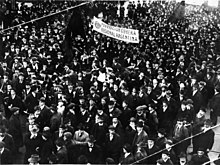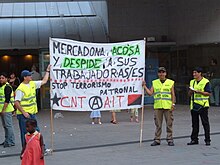Anarcho-syndicalism
The term anarcho-syndicalism describes the organization of wage earners based on the principles of self-determination , self-organization and solidarity . In terms of the history of ideas, anarcho-syndicalism represents a supplement to anarchism with revolutionary syndicalism .
Means and goals of anarcho-syndicalism
The main goal of anarcho-syndicalism is the revolutionary overcoming of the state and capitalist society through the direct takeover of the means of production in union self-organization. Through this act the stateless and classless collective order should arise. In order to achieve this goal, anarcho-syndicalism strives to organize the working class in all areas of social life and thus to create an effective countervailing power to the state and capital . The term working class includes not only wage-dependent employees (workers and employees), but also other social groups such as B. the unemployed, housewives or schoolchildren, i.e. groups that are directly or indirectly involved in the production process of society as a whole.
The main fields of action of anarcho-syndicalism are the class struggle in the company with the means of direct action , as broadly effective agitation as possible for its goals and aspects of cultural and youth work. Anarcho-syndicalism always strives to improve people's living conditions in concrete terms: It demands more wages, shorter working hours, equal rights and a dignified life for all people. Its ultimate goal, however, remains social revolution, which is why reformist tendencies are strictly rejected by the majority of anarcho-syndicalists.
Social revolution
In the process of a social revolution , the capitalist system is to be overcome and anti-authoritarian socialism to be built. For this, the means of production should be collectivized by the producers and the production of goods should be organized according to social needs; that can e.g. B. can be approached via the path of a boardless cooperative , analogous to the approaches successfully established in Argentina on the occasion of the economic crisis that escalated in 2001 . The ultimate goal is an anarchist society in which the material needs of everyone can be met.
history

Anarcho-syndicalism was an extremely influential movement with a large number of members, beginning with the forerunners of the 1880s through the concretising debate at the congress in Amsterdam up to the stabilization in the late 1930s. From 1904 to 1949 the anarcho-syndicalist magazine Die Internationale appeared in four episodes . The anarcho-syndicalist trade union international IAA , founded in the early 1920s, immediately united around 1.4 million people. The strongest anarcho-syndicalist organization of those days was the Spanish Confederación Nacional del Trabajo (CNT), which united about two million members in the late 1930s before Spanish fascism succeeded in smashing them and forcing them underground.
During the Spanish Civil War (1936–39) the idea of social revolution was implemented on a broad basis. In the short period from 1936 to 1937, almost all of Catalan agricultural production, heavy industry , the public transport system and large parts of the service sector were self-managed by the workers. In some sectors of the economy, such as heavy industry or agricultural production, it was possible to achieve strong increases in production, which among other things meant that, for the first time in the history of Catalonia, the entire population was able to be supplied with basic foodstuffs. However, this self-governing economy was completely smashed after a short time by the Stalinist supporters of the PCE and later under the dictatorship of Franco .
In Germany, too, anarcho-syndicalism played an important role for a short time during the violent strikes and fighting in the aftermath of the November Revolution of 1918 (especially in the Ruhr area when the right-wing extremist Kapp putsch was suppressed during the Ruhr struggle ). The anarcho-syndicalist FAUD united around 150,000 to 200,000 people in its ranks between 1920 and 1923, but then rapidly lost members. After the Nazi seizure of power , the last working underground cells were smashed by 1936/37.
A similar fate met with almost all anarcho-syndicalist organizations in Europe during and after the Second World War , many were broken up and almost all of them lost their mass base. Only the Swedish SAC was able to maintain its intact organizational structure, but had to give up many of its principles and its membership in the IAA for its reform-oriented and social partnership course .
Despite its decline, there were some attempts to revive anarcho-syndicalism after World War II. After the end of the Franco dictatorship, the Spanish CNT was able to leave the underground and formally re-establish itself. The CNT-F was founded in France and has had a massive influx of members since the general strike in the mid-1990s, but after a split also had to leave the International Workers' Association in some cases. The FAU was founded in Germany in 1977 , an anarcho-syndicalist trade union initiative that wants to follow the tradition of the FAUD. According to its own information, it has also been growing continuously since the mid-1990s.
The unionist IWW and the international tendency of council communism are close to anarcho-syndicalism . It happens that followers of these currents work together in the same organizations. In Germany this happens temporarily between the FAU and the IWW, in Austria between the FAS and the IWW.
Important representatives
- FAUD (Germany)
- Franz Barwich
- Werner Henneberger
- Willi Paul
- Rudolf Rocker
- Helmut Rudiger
- Alexander Moissejewitsch Shapiro
- Augustin Souchy
- Fritz Köster
- CNT (Spain)
- Anselmo Lorenzo
- Salvador Seguí
- Buenaventura Durruti
- Diego Abad de Santillan
- Federica Montseny
- Juan Peiró
- Luis Andrés Edo
- IWW (USA)
- Other
- Albert de Jong
- Gildardo Magaña
- Fernand Pelloutier
- Pierre Ramus
- Antonio Díaz Soto y Gama
- Clara Gertrud Wichmann
- Albert Camus
literature
- Gerhard Aigte: The development of the revolutionary syndicalist labor movement in Germany in the war and post-war period (1918–1929) . Bremen 2005
- AG Amsterdam / FAU Bremen (ed.): Notes From The Class Struggle. Small group workplace organizing in present-day Germany and the Netherlands . Amsterdam / Bremen 2007
- Franz Barwich / Study Commission of the Berlin Workers' Exchange (1923): 'This is syndicalism'. The labor exchanges of syndicalism . Reprint , Verlag Edition AV , Frankfurt 2005, ISBN 3-936049-38-6
- Walther L. Bernecker : 'Reiner' or 'Syndicalist' anarchism . Syndikat-A Verlag, Moers 2006
- Harald Beyer Arnesen: Anarcho-Syndicalism: A Historical Closed Door… or Not?
- Hans Manfred Bock : Syndicalism and Left Communism from 1918 to 1923 - a contribution to the social and intellectual history of the early Weimar Republic ; First edition 1969, updated new edition 1993, Darmstadt, Wissenschaftliche Buchgesellschaft, ISBN 3-534-12005-1
- Hans Manfred Bock: Anarchosyndikalismus , in: Historical-Critical Dictionary of Marxism , Vol. 1, Argument-Verlag, Hamburg, 1994, Sp. 216-220
- Helge Döhring: Anarcho-Syndicalism. Introduction to the theory and history of an international socialist labor movement , Verlag Edition AV, Lich / Hessen, ISBN 978-3-86841-143-0
- Helge Döhring: So that spring will come in Bavaria! The syndicalist labor movement in southern Bavaria from 1914 to 1933 . Verlag Edition AV, Lich / Hessen, ISBN 978-3-936049-84-8
- Helge Döhring: The press of the syndicalist labor movement in Germany 1918 to 1933 , Edition Syfo 1, Moers 2010, ISBN 978-3-9810846-8-9
- Helge Döhring: Syndicalism and Anarcho-Syndicalism in Germany: An Introduction . Bremen 2006
- Helge Döhring: Syndicalism in the 'Ländle'. The FAUD in Württemberg 1918 to 1933 . Verlag Edition AV, Lich / Hessen 2006, ISBN 3-936049-59-9
- Helge Döring: Anarcho-Syndicalism in Germany 1933–1945 , Stuttgart 2013
- Andreas G. Graf (Mithrsg.): Anarchists against Hitler: anarchists, anarcho-syndicalists, council communists in resistance and exile. Berlin. Lukas Verlag 2001, ISBN 3-931836-23-1
- Wolfgang Haug : "A flame goes out". The Free Workers Union of Germany (anarcho-syndicalists) from 1932 to 1937 ; in: IWK - International Scientific Correspondence, Volume 3, (Berlin 1989)
- Dan Jakopovich: Revolutionary Unionism: Yesterday, Today, Tomorrow ( June 22, 2009 memento in the Internet Archive )
- Gaston Leval: Libertarian Spain. The constructive work of the Spanish Revolution (1936–1939) . Publishing Association, Hamburg 1976
- Jochen Schwenk: The anarcho-syndicalist movement in France . In: Norbert Campagna / Franziska Martinsen (ed.): Understanding of the state in France . Nomos Verlagsgesellschaft, Baden-Baden 2018
- Martin Veith: The anarcho-syndicalist union . Bremen 2000
- Clara Wichmann : The theory of syndicalism (1920). In: Clara Wichmann: From the revolutionary élan. Contributions to the emancipation movements 1917-1922 . Edited by Renate Brucker, Verlag Graswurzelrevolution, Heidelberg 2018, pp. 122–148, ISBN 978-3-939045-36-6 .
- Clara Wichmann: Anarchism and the Union Movement (1922). In: Clara Wichmann: From the revolutionary élan. Contributions to the emancipation movements 1917-1922 . Edited by Renate Brucker, Verlag Graswurzelrevolution, Heidelberg 2018, pp. 164–167, ISBN 978-3-939045-36-6 .
- Milly Witkop -Rocker, Hertha Barwich, Aimée Köster u. a .: The Syndicalist Women's Association . Published by Siegbert Wolf. Classics of the Social Revolt Vol. 17. Unrast Verlag , Münster 2007, ISBN 978-3-89771-915-6
magazine
From 1904 to 1949 the anarcho-syndicalist magazine Die Internationale appeared in four episodes . Episode 1 was the organ of the IAA from 1924 to 1926. The editor was Augustin Souchy .
Movie
- Vivir la utopía - The utopia of life ! Film by Juan Gamero, 1997. (Film about Spanish anarchism from around 1870 to around 1939, based on interviews and historical documents). Description of contents on anarchopedia.org
- The Long Hope Available Online . For six weeks, the filmmakers accompanied Clara Thalmann and Augustin Souchy to the region of Catalonia, where between 1936 and 1939 both actively participated in the struggles against Franco and in the collectivization of the anarchist CNT, the only social revolution from below .

